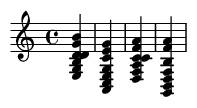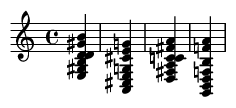Summary:
The iii-vi-ii-V is one of the most elegant and common chord progressions in Western music, particularly in jazz and classic pop. It functions as a powerful extension of the fundamental ii-V-I cadence. By chaining chords whose roots descend by a perfect fifth, it creates a powerful sense of forward momentum and harmonic satisfaction that feels both logical and emotionally resonant.
Keywords:
iii-vi-ii-V progression, circle of fifths, harmonic movement, jazz progression, voice leading, music theory, chord progressions, functional harmony, secondary dominant
Introduction:
If you've ever been captivated by the smooth, sophisticated sound of a jazz standard or a classic pop ballad, you've likely heard the iii-vi-ii-V progression. This sequence is a masterclass in harmonic logic, demonstrating the power of the circle of fifths to create compelling musical narratives. It takes the foundational `ii-V` cadence and extends it, creating a longer, more satisfying journey back to the tonic (the 'I' chord). In this article, we'll dissect this progression, explore its theoretical underpinnings, and show you how to use it in your own music.
The Engine: Root Movement by Fifth
The magic of the iii-vi-ii-V lies in its root movement. In the key of C Major, the progression is Em - Am - Dm - G. Notice the roots of these chords: E → A → D → G. Each root moves down by a perfect fifth (or up a perfect fourth, which is the same interval class). This movement is the strongest, most natural-sounding harmonic motion in tonal music, derived directly from the overtone series. This chain of descending fifths creates a gravitational pull towards a resolution, which is typically the tonic chord (C Major).
Basic Progression in C Major:
This example shows the basic triads in C Major. Listen to how each chord flows seamlessly into the next.
Functional Harmony: The "Why" Behind the Sound
Each chord in this progression serves a clear purpose, guiding the listener on a harmonic journey. In music theory, we categorize chords by their function: Tonic (T) for stability, Predominant (PD) for building momentum, and Dominant (D) for creating tension that demands resolution.
- iii (Em): Tonic Function. The iii chord shares two notes with the tonic I chord (C Major: C-E-G vs Em: E-G-B). This makes it a "tonic substitute," providing a sense of stability but with a more pensive, minor quality. It's a gentle way to leave the home base of 'I'.
- vi (Am): Predominant Function. The vi chord (the relative minor) begins the journey away from the tonic area. It pulls away from the iii chord and sets up the ii chord, acting as a predominant.
- ii (Dm): Predominant Function. The ii chord is the classic predominant. Its job is to prepare for the arrival of the dominant. The move from vi to ii feels smooth, as they are a fifth apart.
- V (G): Dominant Function. The V chord is pure tension. It contains the leading tone of the key (B), which desperately wants to resolve up to the tonic note (C). This chord provides the final push back home to the I chord (C Major).
The journey can be mapped as: Tonic Area (iii) → Predominant Area (vi → ii) → Dominant Area (V) → Resolution (I).
Enriching the Harmony with Seventh Chords
While beautiful with simple triads, the iii-vi-ii-V truly shines when seventh chords are used. Adding the seventh to each chord creates richer textures and, critically, enhances the voice leading. The added notes (the sevenths) create "guide tone lines"—smooth, often stepwise melodic lines hidden within the harmony that pull the progression forward.
Seventh Chord Version (Jazz Voicings):
In this example (Em7 - Am7 - Dm7 - G7), notice the smooth movement in the inner voices, especially the 3rds and 7ths of each chord, which form guide tone lines.

Famous Examples in Music:
This progression is everywhere once you know what to listen for. It forms the harmonic backbone of countless standards and hits.
- "Fly Me to the Moon" - Frank Sinatra: The opening line "Fly me to the moon" uses a version of this progression.
- "Blue Moon" - Richard Rodgers: The entire A-section is built on a variation of I-vi-ii-V.
- "Autumn Leaves" - Joseph Kosma: A jazz standard that is a masterclass in circle of fifths movement, using ii-V-I sequences in both major and relative minor keys.
- "I Will Survive" - Gloria Gaynor: A powerful example in a minor key (Am-Dm-G-C-F-Bm7b5-E) .
- "Sunday Girl" - Blondie: A great pop example of this sophisticated harmony at work.
Advanced Concept: Secondary Dominants
To create even stronger forward motion, jazz musicians often "dominantize" the chords in the sequence. This means turning the minor chords into temporary dominant 7th chords. This technique, called secondary dominance, creates a chain of V-I relationships that pull the listener through the progression with even greater force.
The progression becomes E7 - A7 - D7 - G7.
- E7 is the V7 of Am (V7/vi)
- A7 is the V7 of Dm (V7/ii)
- D7 is the V7 of G (V7/V)
- G7 is the V7 of C (V7/I)
Secondary Dominant Variation:
Listen to the increased tension and chromatic movement in this E7 - A7 - D7 - G7 version.

Putting It Into Practice
Understanding the theory is one thing; using it is another. Here’s how to integrate the iii-vi-ii-V into your musical toolkit.
- Songwriting: Use this progression in a bridge to build tension and provide harmonic contrast before returning to a simpler chorus. It's also perfect for a verse that needs a more sophisticated, flowing feel.
- Improvisation: When improvising, don't just think of the chords; think of the function. Outline the guide tones (3rds and 7ths) to create melodies that perfectly trace the harmonic contours.
- Instrumental Technique: On piano, practice rootless voicings in your right hand over the root in your left. On guitar, find ways to voice the chords so that the top note moves smoothly or creates a compelling melodic line.
- Key Variations: This pattern is universal. Practice it in multiple keys to internalize the sound and function, not just the chord names.
- G major: Bm7 - Em7 - Am7 - D7
- F major: Am7 - Dm7 - Gm7 - C7
- D major: F#m7 - Bm7 - Em7 - A7
Practice Strategies
To master this progression, follow a structured approach:
- Listen and Identify: Play the examples and listen carefully to the root movement. Sing the bass line: E-A-D-G.
- Play the Triads: Master the basic Em-Am-Dm-G version in several keys until the changes are effortless.
- Introduce Seventh Chords: Add the sevenths (Em7-Am7-Dm7-G7) and focus on smooth voice leading. Try to keep common tones and move other voices by the smallest possible interval.
- Learn Repertoire: Learn to play songs that use the progression. Context is the best teacher.
- Experiment with Variations: Try the secondary dominant version (E7-A7-D7-G7). Experiment with rhythmic variations—playing one chord per measure, two chords per measure, etc.
Conclusion
The iii-vi-ii-V progression is far more than just a sequence of chords; it's a fundamental building block of sophisticated harmony. Its power comes from its adherence to the natural laws of acoustics, embodied in the circle of fifths. By understanding its function, practicing its variations, and learning to hear it in the music you love, you unlock a powerful tool for performance, composition, and improvisation. It is a gateway from simple harmony to the rich, expressive world of advanced musical language.
References:
Kostka, Stefan & Payne, Dorothy. (2012). Tonal Harmony. McGraw-Hill.
Levine, Mark. (1995). The Jazz Theory Book. Sher Music Co.
Forte, Allen. (1979). Tonal Harmony in Concept and Practice. Holt, Rinehart and Winston.
Bennett, Dan. (2008). The Total Rock Bassist. Alfred Music.
